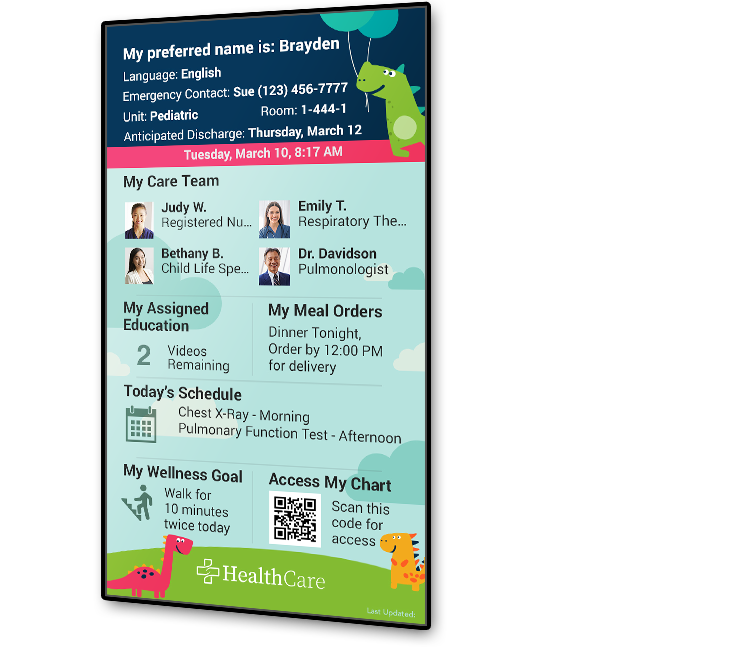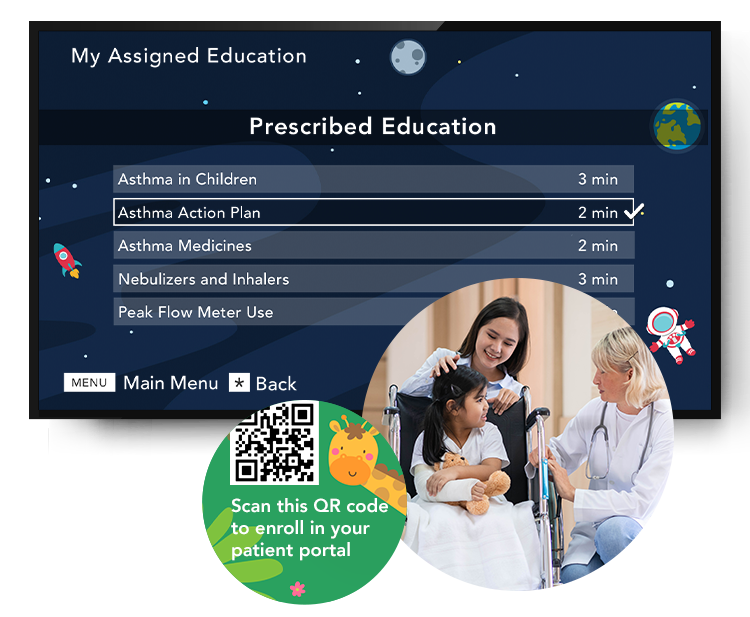
Sometimes the care your hospital needs to provide goes beyond the patient.
In children’s hospitals and pediatric units, every patient also comes with anxious parents (or other guardians or caregivers) constantly looking to staff for support throughout their child’s stay.
Failing to address the needs of a patient’s parents can exacerbate the child’s own stress and anxiety, as well as negatively impact post-discharge care plans and outcomes.1
Here are some ways an interactive platform can help calm parents with the communication, confidence, convenience, and comfort they need most while in the hospital — without adding to the already full workloads of clinicians and other personnel.

1. Communication

With patients in children’s hospitals being too young to be independent decision-makers in their care, parents are key players on the care team.
Digital displays that integrate with your hospital’s EHR and other systems can give parents easy access to:
- Condition-specific education
- Care team details & messages
- Daily schedules & procedure info
- Hospital information & services
These integrated features can be displayed on digital whiteboards and interactive TVs, with information updated in real time to keep parents connected to what’s happening during their child’s stay.
“Information is empowering to the parents who are worried about a sick or injured child,” says Austin Winberg, SONIFI Health’s Director of Clinical Outcomes.
“Providing as much transparent communication as possible helps parents feel in the loop throughout the entire process, and self-assured in taking an active role in their child’s care.”
2. Confidence
In addition to delivering clear communications and up-to-date information while the patient is admitted, you can also give parents confidence in knowing what to expect after discharge.
Many pediatric education providers include videos that cater to helping younger patients understand their condition, as well as videos that speak at a higher level to those responsible for caring for the children outside the hospital.
Complementing these educational videos, a digital, customizable discharge checklist can give parents a systematic way of processing all the information they’ll need for their child’s care planning.

A dedicated “discharge channel” on the interactive TV can highlight:
- Specialized care services
- Community resources
- Support groups
- Patient portal registration & benefits
- Reminders for patients & their parents
“These discharge tools paired with a link to your hospital’s patient portal can show parents details about follow-up appointments and who to contact with questions,” Winberg says. “It’s also where they can find instructions or education for things like wound care, medications or using assistive equipment at home.”
When parents feel well-prepared to care for their child after they leave the hospital, it also sets up patients for successful post-discharge outcomes and lowers their risk of readmission.
3. Convenience
Parents usually don’t want to leave their child’s side in the hospital. Convenient service options available in the patient room help give parents an accommodating sense of control as they focus on soothing their child.
Smart room integrations with your building automation system can let parents autonomously adjust the temperature or lighting in the room, without calling a nurse or waiting for environmental services.

TV or voice controls can be used to submit requests — such as asking for an extra blanket, a visit from a spiritual leader, food orders, or special services your hospital offers — giving a concierge-like feel to their experience.
“You can set up these requests to go directly to the applicable staff with immediate notifications,” Winberg says, “making responses quicker for the family, without interrupting nursing workflows.”
Feedback surveys can give parents a way to provide input and voice concerns while your team is there to help with service recovery.
4. Comfort
Sometimes familiar comforts are exactly what’s needed to calm nerves.
Entertainment and relaxation content like on-demand movies, TV programming, streaming, music, games, soothing sounds, and relaxing visuals in patient rooms offer positive distractions to patients and families when and where they need it most.
“Numerous studies show that giving patients access to quality entertainment and distraction content is associated with a reduction in anxiety and pain2,” says Winberg, “as well as helping patients cope with fatigue and — just like at home — boredom and restlessness.”
Connections that matter
It’s critical to your pediatric patients’ well-being to keep parents engaged in their child’s care, and to give them the tools they need to succeed both in the hospital and at home.
That’s why SONIFI Health is dedicated to reimagining how technology can help create more healing environments and hospitality-centered interactions for your clinicians, your patients, and their parents and caregivers.
Stay connected
Get exclusive insights delivered to your inbox from our experts.
 By SONIFI Health
By SONIFI Health 